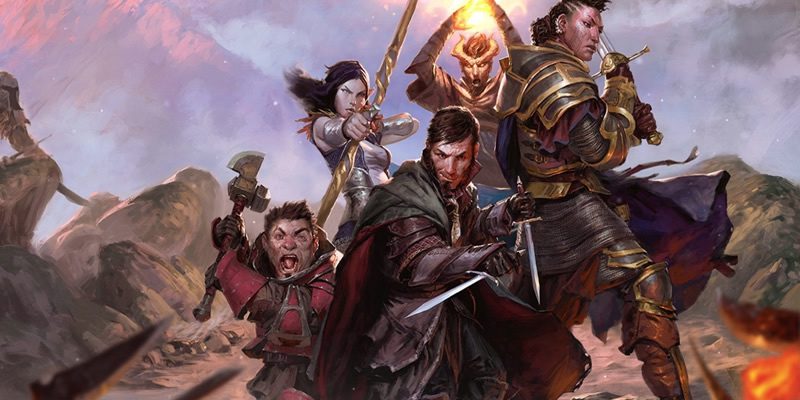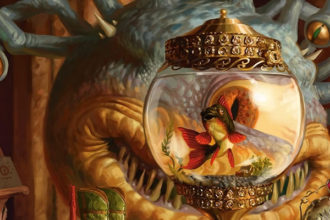UA 2020: Subclasses, Part 2 Breakdown

Tonight, at the Pit, Everyone. Gets… A New. Subclass. In the second part of the deviously-named “Subclasses” series of UA drops, we get a bardic college, a cleric domain, and a sorcerous origin. For those of you keeping score at home, seven of the thirteen classes have gotten a new subclass in this run, to say nothing of the many, many subclasses of the past few months. Personally I’m hoping to see what’s new in feat design soon.
EDIT (2/4/2020, 12:30 pm EST): The Subclasses 2 document has been pulled down, and now only shows the Subclasses 1 PDF.
(2/4/2020, 6 pm EST): @JeremyECrawford: The official version of the Unearthed Arcana article “Subclasses, Part 2” is still ahead of us, later this week or sometime next week.
I’ll update this with any further developments.
Subclasses 1 | Subclasses 2
College of Creation Bard
There was Eru, the One, who in Arda is called Ilúvatar; and he made first the Ainur, the Holy Ones, that were the offspring of his thought, and they were with him before aught else was made. And he spoke to them, propounding to them themes of music; and they sang before him, and he was glad. But for a long while they sang only each alone, or but few together, while the rest hearkened…
–“Ainulindalë,” The Silmarillion, by J.R.R. Tolkien
If you’ve been reading my column for any length of time, this quote should be no surprise. Here we have a bard that expounds the Song of Creation. As a result, it’s also blurring the lines between bard and cleric, in the vein of 4e’s invoker class – and I am so here for that. The flavor text also leans way into planar themes. What it does in the mechanics is another matter – let’s check that out.
- Note of Potential interfaces with Bardic Inspiration, as one would expect of a 3rd-level bard subclass feature. It creates a visible but invulnerable floating object that follows your Bardic Inspiration target around. When they spend Bardic Inspiration, your target also expends the object, in their choice of one of these three different ways.
- Note of Destruction is a splash of AoE damage equal to the result of the Bardic Inspiration die, for each adjacent creature that fails a Con save. The target has to expend the die for an attack roll to use it this way, and they’ve got to take some big positioning risks to use it efficiently, but that damage adds up.
- Note of Protection requires that the die be added to a saving throw, and grants some temporary hit points. These temporary hit points can’t be gained if you have any existing temporary hit points. That’s a little odd – normally “If you have temporary hit points and receive more of them, you decide whether to keep the ones you have or to gain the new ones.” I don’t really see what they’re getting out of closing that door, but there it is.
- Note of Inspiration is maybe an unfortunate naming choice, because of the heavy use of “inspiration” as a formal rules term. Anyway, if you’re spending your die on an ability check, you can reroll the Bardic Inspiration die, and if you do, you must use the new roll. Honestly… that’s kinda janky. You get into a situation where you can use the Note but don’t want to – but it has no way to do anything if you don’t have a Bardic Inspiration die to spend. This needs to be “you can roll the Bardic Inspiration die twice, and use the higher result.” (Incidentally that’s also consistent with Inspiration’s use of advantage, rather than being a reroll, but… this is neither the time nor the place.)
- Performance of Creation at 6th level lets you create a fairly normal item from nothing, for a little while. Its duration is fairly involved – the longer you keep spending actions to maintain it, the longer it stays with you. The use frequency on this feature also does a new thing that subclasses have been doing that I really like – once per long rest, or you can reuse it by burning a spell slot of a given level (in this case, 3rd). One object per customer (that is, at a time).
- I feel completely confident that one of my players in particular – he knows who he is – is already plotting outlandish shenanigans that turn on the temporary ex nihilo creation of something useful.
- Animating Performance at 14th level directly improves your Performance of Creation, turning the widget into a dancing widget – a combat pet, that requires your bonus action to do anything more than defend itself. It’s a pretty great use of your bonus action, though.
- It’s more destructible than a spiritual weapon, for a much longer duration, and deals the damage of spiritual weapon cast at 4th level for a 3rd-level slot. Moves faster. Spiritual weapon is a phenomenal spell from the moment you get it until you retire the character, so getting such a long-lasting version of it as a bard should be awesome.
Two last, burning questions.
- Who is the Creation bard, Belle or the Beast? (Obviously the Genie is a Creation bard.)
- Can I create a teakettle, clock, or candelabra that sings to me and helps me figure out my problems?

But seriously, the story that the mechanics tell isn’t necessarily what I would have expected (though what I would have done with this is idiosyncratic in the extreme), but it does hook into the narrative of the subclass. I expect the gameplay will be a lot of fun, but the use-it-or-lose-it aspect of the Notes is going to generate frustration in use. (Also, getting only three features from your subclass continues to make all bardic subclasses off-putting to me.)
Domain of Love Cleric
I wonder, wonder who, who-oo-ooh, who
(Who wrote the book of love)
Tell me, tell me, tell me
Oh, who wrote the Book Of Love
I’ve got to know the answer
Was it someone from above
(I wonder, wonder who, mmbadoo-ooh, who)
(Who wrote the Book Of Love)–“Book of Love,” by the Monotones
Friends, I am agapē to be reminded how many gods of love there are traditionally, compared to how rare a domain for that portfolio is in D&D. Let me tell you, this one arrives none too Sune. (Setting jokes down for a moment: I know perfectly well why it’s rare – it’s because magically-induced love is among the most phenomenally problematic ideas one can even introduce into a game. Philter of love, you’re well past “on notice;” this domain doesn’t duplicate that effect.)
- The Domain Spells are completely on point – crowd control, buffs, and damage sharing. Yep, does exactly what I would have guessed.
- If you’re surprised to see charm person here, make sure you take a close look at what the spell and the condition do and don’t do. If you’re seeing hold monster as rapey, uh, take a deep breath. The spell has been in the game since the ’70s (not checking right now) – if it only turned rapey when someone used the word “love,” then there’s a problem, but it isn’t this domain.
- Emboldening Bond is bonds-of-camaraderie kind of love – it grants a “shared” bless effect, sort of, that can also add its d4 to ability scores. The targets only benefit from it once per turn, rather than every applicable roll, and they have to stay within 30 feet of each other – but it doesn’t cost concentration, and lasts for an hour. Once per long rest, or refresh by expending any spell slot. Well, this is hugely appealing.
- Channel Divinity: Impulsive Infatuation at 2nd level is a short-term charm that controls how the target uses its reaction: they make an attack against a creature of your choice. You can absolutely use this on a willing ally to let them attack again using their reaction. Wis save to resist, can choose to fail.
- Just so I’ve said it, this is the first big “Include Safety Sidebar!” feature I’ve seen. Or at least, “Don’t be a creeper!”
- Protective Bond at 6th level upgrades Emboldening Bond. One side of the bond can use their reaction to grant the other resistance to all damage. So it’s warding bond except the other side of the bond doesn’t take any damage.
- …le wow!
- Potent Spellcasting 8th level does what Potent Spellcasting does. I don’t blame them for making the Love cleric not a melee brute. Though this would be the perfect cleric to use bow and eros.
- Enduring Unity at 17th level is some straight-up Adventure Romance stuff. The range limit on Emboldening Bond becomes “while on the same plane of existence.” Also, if one member of the bond goes to 0 hit points (regardless of whether they die), the other member gets a huge 1-minute boost: advantage on attack rolls, checks, and saves, resistance to all damage, and healing the partner by touch, by expending Hit Dice.
- Incredibly powerful, interesting, and a great… marriage… of mechanics and narrative. True love really will conquer all, especially if you don’t kill both of the paired characters at the same time.
Personally, I would play this domain as long as I had other party members who were going to engage with the narrative in some sense. It would be incredibly disappointing to target characters with Emboldening Bond and have them not roleplay any connection to one another, not even a rough warrior friendship.
Remember, kids, don’t ever put other players on the spot to roleplay romantic or sexual love without their enthusiastic consent. EVER.
I’ve seen some conversation on Twitter around the question of how well the charmed condition relates to love as we wish to see it, and how much expectation of misuse each reader takes away from Impulsive Infatuation. As I write this, the conversation is just getting started. The point I want to make in strong defense of this implementation is that this absolutely sounds to me like something Aphrodite would do. Other gods of Love… harder to say, they aren’t all as interventionist as she is.
Clockwork Soul Sorcerer
Everything has a purpose, clocks tell you the time, trains takes you to places. I’d imagine the whole world was one big machine. Machines never come with any extra parts, you know. They always come with the exact amount they need. So I figured if the entire world was one big machine… I couldn’t be an extra part. I had to be here for some reason.
–Hugo Cabret in Hugo
It says Clockwork Soul and means “what if your sorcery came from Mechanus?” Since I’m 100% here for maybe some sort of Great Modron March (Primus sucks), well, you can guess that I’m excited to find out what makes this sorcerous origin… tick.
- Manifestations of Mechanus is a d6 table of quirks attached to your spellcasting. The more sorcerous origins get this kind of quirk, the more I like them.
- Restore Balance lets you negate advantage or disadvantage on a creature within 60 feet, by granting both. (There’s a rules sidebar to remind you that granting both means you have neither, no matter how many other sources of advantage or disadvantage may apply.) It costs your reaction, and you can do it Cha modifier times per long rest.
- Okay, as with anything where you spend a resource to grant/impose dis/advantage at the time of the roll, you’re going to have a lot of times when you look at the roll and have no idea if your reaction changed anything. Sure, if there are additional “when you have advantage” effects, as with Sneak Attack or the Samurai subclass, it’ll be much clearer that you’ve Done Something. Without that… the roll succeeds or fails, but maybe that was going to happen anyway?
- Bulwark of Law at 6th level lets you convert sorcery points into damage mitigation for yourself or another creature, at 1d6 per point, up to 5 at a time. You can only maintain one Bulwark at a time, but still – there are very few “mana shield” effects in D&D, and it’s fascinating to see one here.
- Leader vibes off a sorcerer? Don’t see that every day. I like it.
- Trance of Order at 14th level a self buff that takes an action to activate (that’s kind of surprising by itself – we’re seeing a lot of this kind of self-target super-mode stuff go to bonus actions these days), and lasts for a minute. During that time all of your natural rolls of 9 or lower count as natural 10s, and no advantage that is formed against you shall prosper. Once per long rest, or burn 5 sorcery points to do it again.
- Hint: the math is tuned so that if you roll a 10, you’re succeed almost all of your rolls. This is staggeringly Sometimes all you even need is a way to lock out natural 1s!
- Clockwork Cavalcade at 18th level summons a host of modrons (they’re not marching, it’s not time yet) – well, spirits that look and act like modrons – that stabilize the dying, repair what’s broken, and end all spell effects of 5th level and lower in the 30-foot-cube effect area. It costs your action to use, which feels about right, and you can use it once per long rest, or spend 5 sorcery points to use it again.
- This isn’t generally as dominating as Trance of Order, but if it does what you need, nothing else will do. I would at least consider letting that “stabilize” get bumped up to restoring some hit points.
This is a fascinating sorcerous origin. I love how much it hooks into D&D lore and feels like Planescape. I’m not looking it up, but several of these features could very plausibly be lifted from Planescape: Torment. The worst I can say of this is that 5 sorcery points a pop is a big drain on the sorcerer’s main currency, without any extra sorcery points granted. Of course, you could restrict yourself to one use of Trance of Order and one of Clockwork Cavalcade per long rest, so the only currency-guzzler in the bunch is Bulwark of Law… but be real with yourself here.
The other thing I note about this is that if you ever wanted a sorcerer version of Neo (or Agent Smith) in The Matrix, this is probably as good as you’ll get.
Conclusion
All three of these are exciting, vibrant subclasses, with big ideas that plug into the D&D multiverse. Of them, I’m most eager to play the Love domain, but I’d give all three a shot. The Clockwork Soul does one thing in particular that many sorcerous origins don’t, not counting the Divine Soul: it suggests new character motivations that are about your subclass. I feel like a possible obvious goal is to go to Mechanus and figure out what it means to you.
Finally – thank you to everyone at Wizards of the Coast who made all of my dumb jokes in this article possible.



